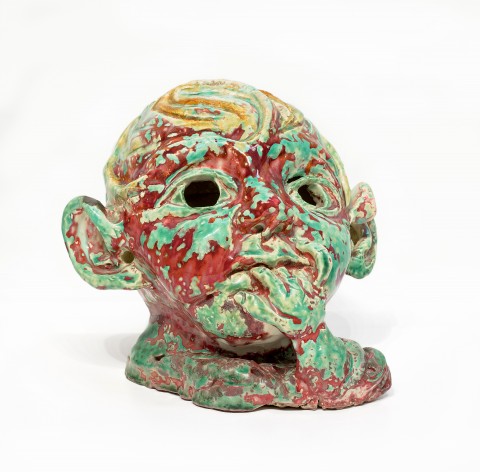HEAD OF AN ANGEL, 1961
JOHN PERCEVAL
glazed earthenware
19.5 x 21.0 x 21.0 cm
signed and dated on base: John Perceval 61
Private collection
Deutscher~Menzies, Melbourne, 4 June 2003, lot 37
Private collection, Melbourne
In August 1959, seven young artists, inheritors of a strong social realist tradition in Melbourne, gathered with the historian Bernard Smith to present an exhibition and manifesto at the Victorian Artists’ Society, titled Antipodeans. Stridently opposing the tide of abstraction, The Antipodeans had proclaimed it was ‘both a right and a duty to draw upon our experience both of society and nature in Australia for the materials of our art.’1 Within this historically significant exhibition, the young John Perceval exhibited a selection of sculpted earthenware Angels, a series that dominated his practice from 1957 – 1962 and had already received much critical and commercial acclaim. His only sculptural ceramic works, the Angels are amongst Perceval’s best-known creations and are now considered to be among the most important series within Australian modernism, alongside Sidney Nolan’s ‘Kelly’ paintings, Arthur Boyd’s ‘Love, Marriage and Death of a Half-Caste Bride’ and Albert Tucker’s ‘Images of Modern Evil’. Consequently, the cherubic and mischievous figures are rare to appear on the market, with many examples held in state and national collections across Australia.
Wide-eyed and disarmingly innocent, Head of an angel was created in 1961. The later examples of Angels were more lavishly detailed than their predecessors, their profane actions increasingly sculpted rather than wheel-thrown. Bringing chubby hands up to its toothless mouth in a distinctly infantile gesture, this baby angel’s head is smoothly fashioned and uniformly coated with a mottled and iridescent burgundy-and-turquoise glaze. As noted in a review within the Bulletin, underpinning the exuberance, thoughtfulness and tenderness of these works was Perceval’s ‘astonishing craftsmanship.’2
Perceval’s prowess as a ceramicist was reflective of his close and enduring connection with the Boyd family in Murrumbeena, Victoria. Inspired by the ceramic works of patriarch Merric Boyd, Perceval and Arthur Boyd founded the Arthur Merric Boyd Pottery (AMB) in 1944 and began producing painted earthenware domestic ceramics as a means to fund their fine art practice. It was only in 1954, when purchasing a house with a new kiln, that Perceval and his young family ended a period of what Franz Philipp called ‘aristocratic poverty.’3 Retreating then into the domestic sphere, at time when his immediate peers were travelling to find their fortunes in London, Perceval used his new kiln to experiment with glazes, particularly the prized ancient Chinese glaze the Europeans called sang-de-boeuf, an elusive colour that had also obsessed his father-in-law, Merric. Stumbling upon a similar effect through a low-temperature reduced copper lustre glaze using experimental materials such as naphthalene and linoleum in the final stages of firing, Perceval produced a surface that he reserved for something more precious than his previous ceramics.4
The genesis of these angels can be found in the rough urchins of Perceval’s semi-autobiographical child-in-the-street paintings of the 1940s – although here their marked delicateness expresses instead a hopeful, terrestrial, joie de vivre. While the upturned, trusting face of this angel was anchored in the artist’s immediate experience of raising four children, the broader context of the threat of nuclear warfare also informed the Angels of the early 1960s. Perceval commented that they were ‘more or less… symbols of the world’s survival… war babies, the precious creatures we run the risk of losing.’5
1. Smith, B., ‘The Antipodean Manifesto’, The Antipodeans, Victorian Artists’ Society, Melbourne, 1959
2. ‘Sundry Shows, Fallen Angels’, The Bulletin, Sydney, vol. 80, no. 4137, 27 May 1959, p. 23
3. Philipp, F., Arthur Boyd, Thames and Hudson, London, 1967, p. 215
4. Smith, D., Delinquent Angel: John Perceval’s Ceramic Angels, Shepparton Art Museum, Victoria, 2014, p. 13
5. Hetherington, J., ‘John Perceval. His angels affirm his faith in man’, The Age, Melbourne, 24 March 1962, p. 18
LUCIE REEVES-SMITH
